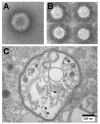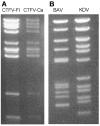Coltiviruses and seadornaviruses in North America, Europe, and Asia
- PMID: 16318717
- PMCID: PMC3367365
- DOI: 10.3201/eid1111.050868
Coltiviruses and seadornaviruses in North America, Europe, and Asia
Abstract
Coltiviruses are tickborne viruses of the genus Coltivirus. The type species, Colorado tick fever virus (from North America), has been isolated from patients with flulike syndromes, meningitis, encephalitis, and other severe complications. Another coltivirus, Eyach virus, has been isolated from ticks in France and Germany and incriminated in febrile illnesses and neurologic syndromes. Seadornaviruses are endemic in Southeast Asia, particularly Indonesia and China. The prototype virus of the genus, Banna virus (BAV), has been isolated from many mosquito species, humans with encephalitis, pigs, and cattle. Two other seadornaviruses, Kadipiro and Liao Ning, were isolated only from mosquitoes. The epidemiology of seadornaviruses remains poorly documented. Evidence suggests that BAV is responsible for encephalitis in humans. Infection with BAV may be underreported because it circulates in regions with a high incidence of Japanese encephalitis and could be misdiagnosed as this disease.
Figures





References
-
- Attoui H, Billoir F, Biagini P, de Micco P, de Lamballerie X. Complete sequence determination and genetic analysis of Banna virus and Kadipiro virus: proposal for assignment to a new genus (Seadornavirus) within the family Reoviridae. J Gen Virol. 2000;81:1507–15. - PubMed
-
- Attoui H, Mohd Jaafar F, de Lamballerie X, Mertens PPC. Seadornavirus, Reoviridae. In: Fauquet CM, Mayo MA, Maniloff J, Desselberger U, Ball LA, editors. Virus taxonomy: eighth report of the international committee on taxonomy of viruses. London: Elsevier/Academic Press; 2005. p. 504–10.
-
- Koprowski H, Cox HR, Miller MS, Florio L. Response of man to egg-adapted Colorado tick fever virus. Proc Soc Exp Biol Med. 1950;74:126–31. - PubMed
-
- Florio L, Miller MS, Mugrage ER. Colorado tick fever: isolation of the virus from Dermacentor andersoni in nature and laboratory study of the transmission of the virus in the tick. J Immunol. 1950;64:257–63. - PubMed
Publication types
MeSH terms
LinkOut - more resources
Full Text Sources
